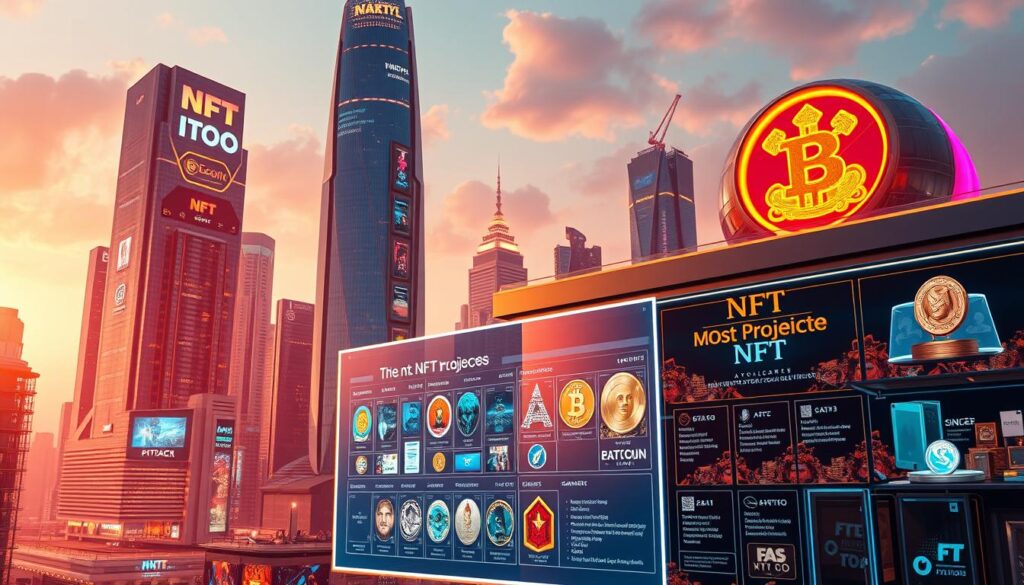Now Reading: Unlock the Power of NFT Metadata
- 01
Unlock the Power of NFT Metadata
Unlock the Power of NFT Metadata

Every digital collectible carries a hidden blueprint that defines its identity. This critical layer of information acts like a fingerprint, distinguishing unique items in blockchain ecosystems. From art to virtual real estate, these details shape how assets interact with platforms, buyers, and smart contracts.
Think of this data as a digital passport containing titles, descriptions, and media links. Attributes like rarity scores or unlockable content transform static files into dynamic experiences. Properly structured details boost search visibility across marketplaces while proving ownership authenticity.
This guide reveals how creators leverage these components to build value and engagement. We’ll explore standards that ensure compatibility across wallets and applications. You’ll discover tools for crafting descriptions that resonate with collectors and algorithms alike.
Beyond basic identification, strategic data design unlocks revenue streams through programmable features. Imagine concert tickets that upgrade based on fan loyalty or artwork that evolves through community input. These possibilities emerge when technical precision meets creative vision.
Key Takeaways
- Digital labels determine asset authenticity and ownership verification
- Strategic data design improves marketplace discoverability
- Attributes enable special features through smart contracts
- Proper structuring supports cross-platform compatibility
- Dynamic elements create interactive user experiences
Understanding the Fundamentals of NFT Metadata
Behind every unique digital asset lies a structured set of descriptors that bring it to life. These components form a bridge between blockchain records and real-world meaning, turning cryptographic entries into recognizable collectibles with distinct identities.
Definition and Core Components
This informational layer contains five essential elements:
- Title: A unique identifier distinguishing one item from others
- Description: Context explaining the asset’s purpose or story
- Media links: Direct connections to images, videos, or audio files
- External references: URLs to creator websites or verification tools
- Traits: Specific characteristics determining rarity or function
The Role of Structured Information in Blockchain Systems
Properly organized details enable three critical functions across platforms:
- Ownership verification through permanent creation records
- Enhanced searchability via marketplace indexing systems
- Smart contract activation for exclusive content access
This framework allows non-fungible tokens to interact seamlessly with wallets, apps, and trading environments. Standardized formats ensure assets maintain their properties when moving between ecosystems, preserving both utility and value.
The Role of Metadata in Authenticity and Ownership
Digital ownership relies on verifiable proof that can’t be duplicated or altered. Hidden within every blockchain transaction lies a network of data points that act as both birth certificate and life story for digital assets.

Establishing Provenance and Trust
Blockchain records create an unbroken chain of custody. Three elements form this trust framework:
- Creator signatures locked during minting
- Time-stamped ownership transfers
- Royalty percentages encoded in smart contracts
These components let collectors confirm an asset’s origin through transparent history. Marketplaces use this data to filter counterfeit items, protecting buyers from fraudulent listings.
Verifying Authenticity through On-Chain Data
Critical verification fields include:
- Update Authority: Shows who can modify asset details
- Mint Address: Proves original creation source
- Creators Array: Lists all royalty recipients permanently
When paired with external verification tools, this information becomes armor against fraud. Artists benefit through automatic royalty payments triggered by resales, creating sustainable income streams from their work.
How Metadata Enhances Discoverability and Engagement
The right details can make or break a digital item’s visibility in crowded markets. Organized information acts like a search magnet, pulling interested buyers toward unique assets. This system works behind the scenes across trading platforms and virtual galleries.
Indexing on Marketplaces and Platforms
Digital marketplaces use descriptive data like a librarian organizing books. Three key elements power their search engines:
- Trait filters: Sort assets by rarity scores or visual features
- Collection tags: Group related items for thematic browsing
- Keyword matching: Connect user searches to relevant titles/descriptions
These systems help collectors find hidden gems faster. A well-crafted title with unique characteristics might appear in 10x more searches than generic listings.
Driving User Engagement with Rich Data
Interactive elements turn passive viewers into active participants. Consider these engagement boosters:
- Unlockable content revealed after purchase
- Progress bars showing limited edition status
- Community voting systems tied to asset evolution
Platforms using these features see 40% longer user sessions. When collectors understand an item’s backstory and utility, they’re more likely to invest time and resources.
Exploring Attributes: The Heart of NFT Metadata
Digital collectibles gain their personality through customizable building blocks called attributes. These markers act like DNA strands, shaping how items appear, function, and evolve within blockchain environments.

Common Attribute Types and Their Significance
Four primary categories define most projects:
- Rarity tiers: Scarcity indicators like “legendary” or “1-of-1” create instant perceived value
- Utility flags: Access passes for events, software, or community benefits
- Visual identifiers: Color schemes, accessory types, or artistic styles
- Performance metrics: Game character stats or achievement levels
Platforms like OpenSea recognize specific formats for numerical values and dates. Proper coding ensures traits display correctly across marketplaces.
Utilizing Attributes to Enhance Digital Asset Value
Strategic trait combinations drive 73% of collector decisions in top-tier projects. A gaming character with unique weapon skills might trade 5x higher than base models. Artists boost engagement by letting owners unlock hidden features through trait interactions.
Best practices include:
- Using consistent naming conventions across collections
- Balancing common and rare characteristics
- Linking traits to real-world benefits
Integrating Metadata with NFT Creation Platforms
The right software transforms creative visions into blockchain-ready masterpieces. Modern creators choose from three main solution types, each catering to different skill levels and project scales.
Choosing the Right Metadata Generators and Tools
Web-based generators like NFT-Maker and thirdweb simplify the process creating basic collections. These platforms offer drag-and-drop interfaces for adding traits and descriptions. Ideal for small batches, they automatically format data for blockchain compatibility.
Developers handling complex projects often prefer JSON editors. Tools like Visual Studio Code provide granular control over attributes and file structures. This approach works best for collections requiring custom logic or layered rarity systems.
For enterprise-scale deployments, blockchain development platforms deliver robust solutions. OpenZeppelin’s templates enable seamless integration with smart contracts, while HashLips Art Engine automates bulk generation. These systems handle everything from media compression to trait randomization.
Key selection criteria include:
- Compatibility with target marketplaces and wallets
- Batch processing capabilities for large collections
- Error-checking features for data validation
Leading platforms now offer live previews showing how assets will display across devices. This prevents formatting issues before deployment. Always test generators with sample files to ensure consistent output quality.
Developing Robust NFT Metadata Structures and Standards
Building reliable data frameworks requires precise technical architecture. Consistent formatting ensures blockchain items function across wallets and marketplaces. Properly structured information acts like universal translation for smart contracts and platforms.

JSON Formatting Essentials and Best Practices
Most systems use JSON files to organize asset details. These text-based documents follow strict formatting rules:
- Mandatory fields: Name, description, and media links
- Proper nesting: Attributes within dedicated subcategories
- Value types: Strings in quotes, numbers without formatting
Common errors include missing commas or mismatched brackets. Validators like JSONLint catch these issues before deployment. Always test files across multiple platforms – OpenSea displays some fields differently than Rarible.
Understanding ERC-721 and ERC-1155 Standards
ERC-721 remains the go-to choice for unique collectibles. Each token links to individual JSON data through tokenURI functions. ERC-1155 supports batch operations but requires careful uri formatting for mixed asset types.
Key differences include:
- Metadata storage methods (on-chain vs off-chain)
- Royalty handling in smart contracts
- Collection grouping capabilities
Platforms like Enjin recommend adding animation_url fields for interactive content. Developers should reference official schema templates to avoid compatibility issues during integration.
Advanced Techniques for Large NFT Collections
Crafting extensive digital collections demands industrial-grade precision. Specialized systems manage thousands of unique assets while maintaining cohesive branding and functionality. This requires balancing automation with meticulous oversight.
Scaling Metadata for Bulk NFT Creation
Tools like HashLips Art Engine automate trait combinations through layered templates. Developers set rules for attribute distribution, ensuring rare characteristics appear at predetermined rates. Batch processing handles media compression and file naming simultaneously.
Effective systems prevent duplicate assets through algorithmic checks. Rarity curves get visualized before deployment, letting creators adjust trait probabilities. Version control tracks changes across iterative updates.
Performance optimization becomes critical above 10,000 items. Decentralized storage solutions like IPFS cluster files for faster retrieval. Database indexing ensures quick searches across massive collections.
Quality assurance pipelines use automated validators to flag mismatched attributes. Cross-platform testing verifies consistent display across marketplaces. Partnering with technical experts streamlines deployment while avoiding costly errors.
Seasoned development teams implement error-correcting workflows. These professionals ensure smart contracts interact flawlessly with descriptive data layers. Their expertise transforms ambitious concepts into market-ready digital assets.
Solana NFTs and the Impact of On-Chain Metadata
Solana’s approach to digital assets revolutionizes how blockchain networks handle token information. The network’s architecture supports rapid verification processes while maintaining robust ownership records. This efficiency stems from specialized protocols that manage critical data layers.
Understanding the Metaplex Protocol
The Metaplex standard anchors token details directly on-chain through Program Derived Addresses. These PDAs link mint accounts to essential fields like Update Authority and Creator Arrays. A token’s URI field connects to decentralized storage for supplementary media files and descriptions.
Certified Collections use a unique method to group assets. By assigning a shared mint address to the collection field, projects establish verifiable relationships between tokens. This system prevents counterfeit items from appearing in authenticated sets.
Verifying Collections with Candy Machine Tools
Candy Machine’s tracking mechanism inserts a creator address with 0% royalties at position zero. Versions like Magic Eden’s forked CM tool enhance this process for marketplace compatibility. Developers leverage these tools to automate batch deployments while ensuring proper collection tagging.
Mutable flags in on-chain data allow controlled updates post-launch. This flexibility helps creators fix errors or refresh content without compromising the asset’s core identity. Combined with Solana’s speed, these features redefine scalable digital ownership solutions.
FAQ
What core elements are included in a digital collectible’s data structure?
A typical data structure includes a name, description, image or media URL, and traits like rarity or edition number. These components are stored in JSON format, often hosted on decentralized platforms like IPFS or Arweave to ensure permanence.
How does on-chain information verify ownership of digital assets?
Blockchain explorers like Etherscan or Solscan track transaction histories and smart contract details, linking wallets to specific tokens. This transparency allows anyone to confirm an asset’s origin and ownership without relying on third parties.
Why do platforms like OpenSea prioritize rich data for listings?
Detailed attributes—such as color schemes, artist credits, or interactive features—help algorithms categorize items accurately. This improves search visibility and attracts targeted audiences, boosting engagement and sale potential.
What tools simplify bulk creation for extensive projects?
Platforms like HashLips Art Engine or Candy Machine v3 automate trait randomization and JSON generation. These solutions support batch uploads to marketplaces, reducing manual errors while maintaining consistency across thousands of items.
How do ERC-721 standards influence interoperability?
ERC-721 defines a universal template for token details, ensuring compatibility across exchanges like Coinbase NFT or Magic Eden. This standardization lets users trade assets seamlessly while preserving unique characteristics across ecosystems.
What advantages does Metaplex offer for Solana-based projects?
Metaplex’s protocol embeds traits directly into on-chain accounts, eliminating reliance on external storage. Tools like Candy Machine verify collection integrity, while marketplaces like Magic Eden auto-display properties without manual input.
Can outdated JSON files affect resale value?
Yes. If hosted on centralized servers, broken links can render traits invisible. Using permanent storage like IPFS or Arweave ensures attributes remain accessible, preserving provenance and long-term valuation.
How do rarity calculators impact pricing strategies?
Tools like Rarity.tools or Trait Sniper analyze trait distributions within collections, highlighting scarce features. Sellers use these metrics to justify premium pricing, while buyers assess investment potential based on statistical uniqueness.














